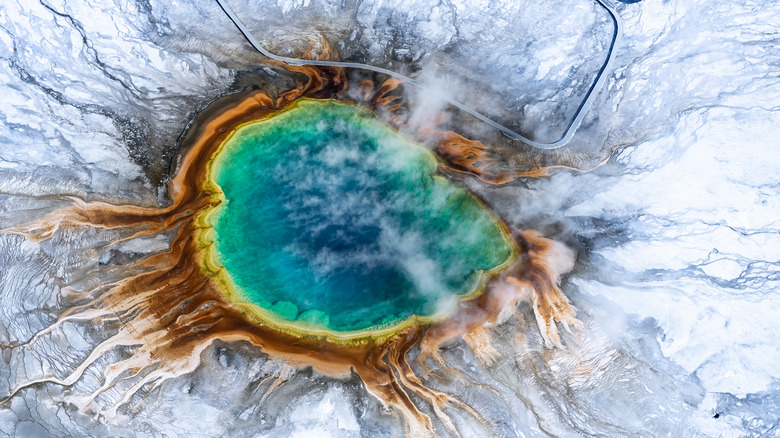Yellowstone National Park in Wyoming, Idaho, and Montana
With its jewel-colored hot springs, crystal-clear lakes, and dense pine forests, Yellowstone’s beauty is always unparalleled, but winter may be the best time of year to visit Yellowstone. Wintertime visitors can enjoy the park’s most beloved attractions without the huge summertime crowds, leaving plenty of time to truly drink in the park’s countless natural wonders. There’s also nothing quite like seeing the geyser Old Faithful, the iridescent Grand Prismatic Spring, or the park’s many other hydrothermal features breathing steam over snowy ground.
Visiting Yellowstone in the winter requires some preparation, as four out of five of the park’s main entrances are closed to vehicles from November to April, so you’ll want to book a snowmobile or coach tour if you want to see the park up close. Once inside, though, you’ll be met with 2.2 million acres of stunning natural wonders replete with plenty of activities intrepid visitors will love, from dogsledding to cross-country skiing.
Winter is also a perfect time of year to try to spot some wildlife. You might see snow-dusted bison, elk, or even wolves, and the park offers wildlife tours including guided snowshoe tours with wolf ecologists if you’re seeking more intimate encounters. Whenever you feel like escaping the cold, the park offers insulated snowcoach tours, and you can always unwind with a dip in a nearby hot spring.
Joshua Tree National Park in California
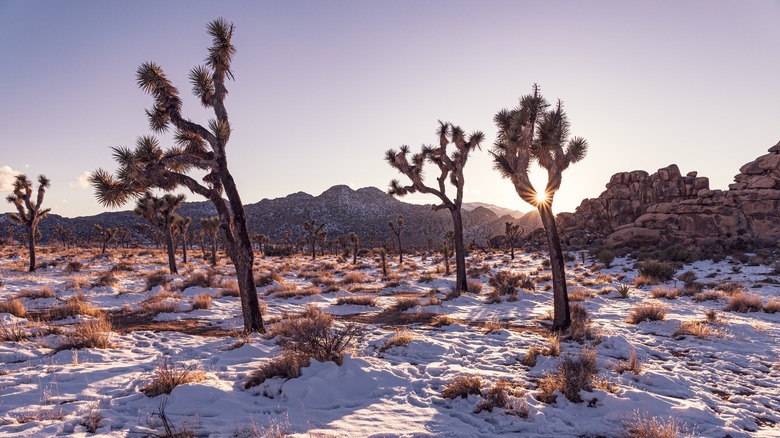
Joshua Tree National Park exists at the intersection of two desert ecosystems — the Mojave and the Colorado — which already makes it a one-of-a-kind landscape. In winter, though, the park’s massive rock formations and signature spiky trees can take on a frosty sheen, making the landscape look even more alien and mystical. The park has long been a hub for artists, bohemians, and wanderers of all stripes, inspiring everything from outsider art to U2’s classic album “The Joshua Tree,” and it’s not hard to see why, once you’ve wandered through its labyrinthine paths and seen the stars at night while the Salton Sea glitters in the distance.
In the winter, visitors can enjoy all of this while avoiding the summer heat, which can often reach dangerous highs. A wintertime visit to Joshua Tree offers hikers, boulderers, and adventurers of all stripes the chance to explore the park’s trails and strange rock formations without risking brutal temperatures. It can get quite chilly at night in the winter, though, so be sure to pack layers, particularly if you choose to camp out.
There’s so much to absorb in the park in the winter months, from classic attractions like Cholla Cactus Garden and Skull Rock to history-rich abandoned mines and hidden caves. Plus, the nearby towns of Yucca Valley, Joshua Tree, and Twentynine Palms boast excellent cafes, galleries, and shops, all perfect for refueling before heading back out to drink in a bit more desert inspiration.
Bryce Canyon National Park in Utah
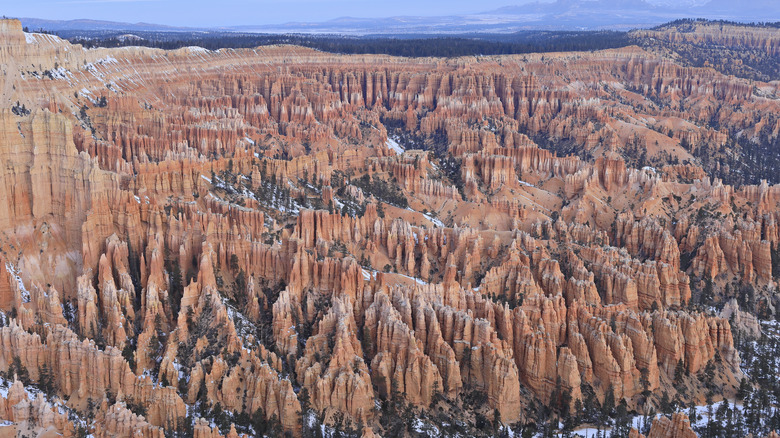
S. Greg Panosian /Getty Images
With its rows of tall, thin rock formations known as hoodoos, Bryce Canyon National Park boasts a wholly unforgettable landscape that becomes even more unearthly when covered in snow. The park rests at an elevation of around 8,000 feet, meaning that wintertime visitors can enjoy stunning views of the hoodoo-filled amphitheaters from one of the park’s many viewpoints before descending down to see them up close. Activities like snowshoeing and cross-country skiing also allow for a closer look at the landscape, which includes alpine forests and striped red limestone and sandstone cliffs.
There are plenty of fun seasonal activities that winter visitors can enjoy, such as ranger-led full moon hikes, which are free when snow levels reach 16 inches or higher. You can also plan a visit around the park’s yearly winter festival, which is held on President’s Day weekend and features competitions, sports and wellness classes, and of course, many opportunities to explore the park’s mystical depths.
Acadia National Park in Maine
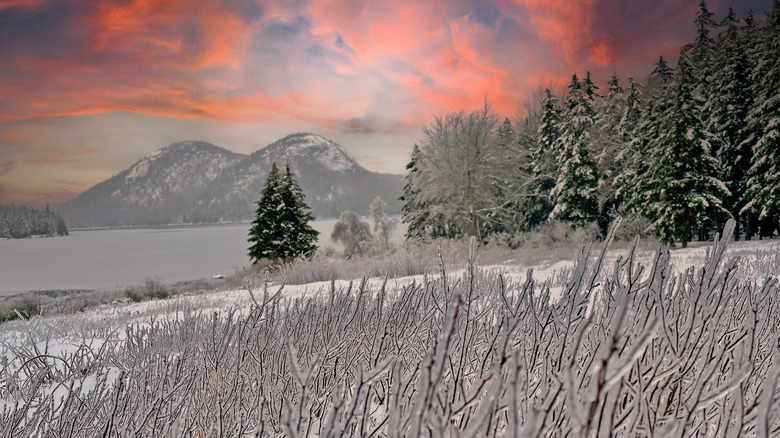
Douglas Rissing/Getty Images
With its rugged, pine-covered cliffs that brush up against the wild Atlantic Ocean, Maine’s Acadia National Park is a slice of heaven for nature lovers year-round. In the winter, this park becomes a wonderland for adventurous spirits, offering plenty of snowshoeing and skiing opportunities for anyone willing to brave the cold. Visitors can also enjoy plentiful birding opportunities, encountering everything from snowy owls to eagles and black-capped chickadees while wandering the park’s snow-dusted beaches and forests — which, in all likelihood, you just might have to yourself during the winter months. Particularly intrepid souls can even try scaling an icy waterfall with year-round ice climbing tours courtesy of Acadia Mountain Guides.
Visitors can also drive around Acadia’s Park Loop Road to drink in the sights from the safety of a heated vehicle. Only two sections of Park Loop Road are open during the winter, but they still offer breathtaking coastal views and are also kept sanded and plowed during the day. If you’re looking for an even more awe-inspiring way to see the park, Scenic Flights of Acadia also runs year-round plane rights that will allow you to admire the area’s mountains, lighthouses, and islands from a bird’s perspective.
In terms of accommodation, Acadia’s Blackwoods Campground is also open during the winter months, but if you’re looking for slightly cozier lodging, the nearby town of Bar Harbor offers a charming slice of Maine life. The town boasts plenty of restaurants, lodging options, and bars where you can pick up a wide variety of blueberry-flavored drinks.
Zion National Park in Utah
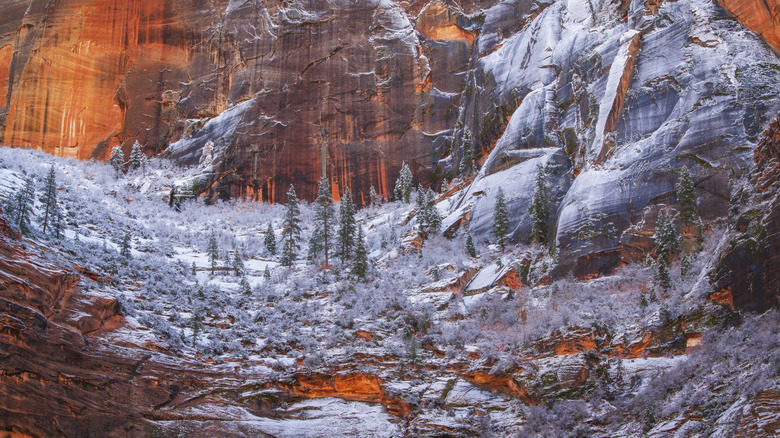
Joseph Rossbach /Getty Images
With its extraordinary array of canyons and rivers and its dazzling array of colors and natural life, Zion National Park is a beautiful location to visit no matter the season. Located in southwest Utah at the intersection of the Colorado Plateau, Great Basin, and the Mojave Desert, this park offers a unique and majestic array of sandstone cliffs, canyons, rock arches, and wildlife guaranteed to remind you of nature’s raw power and grandeur.
The park’s beauty has made it a popular destination for visitors from all over the world, meaning that summertime can become extremely crowded. The winter, however, allows for a bit more quiet and solitude. Winter is also the only season you’ll have the chance to drive your own vehicle through the whole park even if you aren’t staying in the stately Zion National Park Lodge.
Winter temperatures in Zion can range from 50 to 60 degrees Fahrenheit during the day to below freezing at night, meaning you’ll definitely want to pack layers as well as boots that can accommodate icy trails. On the plus side, sunshine is often plentiful at Zion, and you’ll be able to admire glittering, icy rivers, snow-capped peaks, and rainbow-colored cliffs as you explore the park’s pine forests, cliffs, and many hiking trails. Whether you’re hiking iconic Angel’s Landing, which is a dangerous hike in Zion during winter, driving Mt. Carmel Highway, or traversing the sand dunes and rock formations of the park’s east side, you’re sure to encounter views that will stay with you for a lifetime.
Yosemite National Park in California
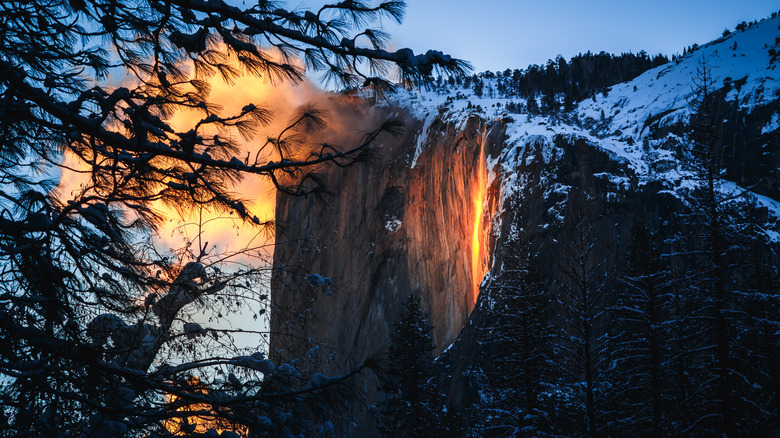
Engel Ching/Shutterstock
Cradled in California’s Sierra Nevada mountains, Yosemite is a wonderland of beaches, rivers, stunning waterfalls, redwood forests, and so much more. Its natural wonders come alive in a whole new way in the winter, and visitors during this time of year will be able to hike the park’s snowy trails, passing by icy rivers, reflective lakes, and snow-covered trees.
The park is often entirely covered in snow during the colder months, though conditions can vary dramatically. While some seasonal shutdowns do go into effect, many of the park’s hiking trails do remain open during the winter, including a half-mile trek to the gorgeous Bridalveil Falls and the 2.4-mile trail to see Mirror Lake, which often dries up in the summer and fall, making winter the perfect time to drink in its reflective views. More adventurous visitors can also enjoy the 11.5-mile Valley Loop Trail, which will take you up close to many of the park’s myriad of wonders.
The winter season at Yosemite is full of unique and tantalizing activities, from ice skating in Yosemite Valley against the backdrop of Glacier Point to snowshoeing through the giant sequoias of Mariposa Grove. Additionally, you might have the chance to see the widely beloved “Firefall” — a phenomenon where the setting sun lights up Horsetail Fall as it plummets over the cliffs of El Capitan, creating what looks like a trail of liquid fire racing down the mountainside.
Everglades National Park in Florida
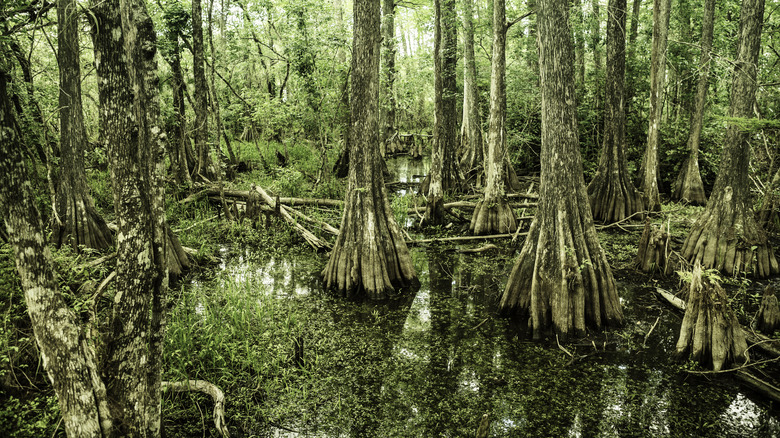
Chang/Getty Images
If you’re looking to escape the cold instead of venturing deeper into it during the winter, a visit to Florida’s Everglades National Park promises a temperate and blissfully mosquito-free experience. Everglades National Park protects around 20% of Florida’s Everglades and spans 1.5 million acres. The park contains a rich and complex web of interconnected ecosystems that showcase the natural world’s ability to generate balance, abundance, and regenerative systems that support a range of life forms.
Visitors can reach the park through one of three entrances — Everglades City in northern Naples, Miami in the northeast, and Homestead in the southeast. A winter visit means you’ll be seeing the park in its dry season, which means fewer insects and easier access to hiking trails that can often flood in the wetter months. The dry season can be crowded, but visitors will definitely have abundant opportunities to birdwatch, hike, camp, or enjoy airboat or kayak rides through the park’s lush landscape.
Overall, boating is a perfect way to take in this lush park’s mangrove forests and cypress groves, and guided tours and fishing trips are available if you aren’t up to kayaking and navigating the labyrinthine wetlands on your own. You can also hike, bike, or take a tram through the green wilds of the park’s verdant acres. No matter what mode of transportation you choose, you’re guaranteed to come in contact with lots of wildlife, which might include both alligators and crocodiles, as well as peacocks, sea turtles, and more. The park is also home to over 360 species of birds.
Death Valley National Park in California and Nevada
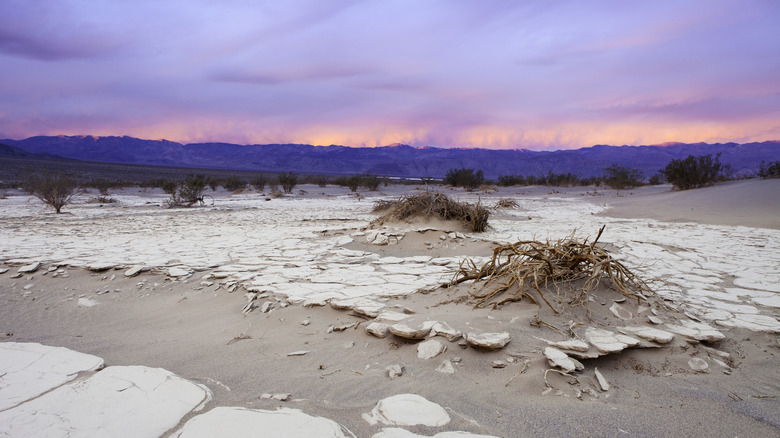
Alex Kay/Getty Images
True to its name, Death Valley National Park can be unbearably hot in the summertime, making winter an ideal time to visit this formidable, mysterious desert landscape. In the depths of winter, Death Valley can even grow chilly at night, but crisp daytime weather is perfect for hikes and long drives through the park’s many natural wonders, which include sprawling salt flats, volcanic craters, and canyons splashed with colorful mineral deposits.
Resting on the border of California and Nevada, this vast desert landscape is both the hottest place in the world and the driest place in North America. It may look inhospitable, but life has long thrived in its harsh conditions. Amid the scorched vistas, you’ll find creosote bushes, Joshua trees, and the occasional smattering of wildflowers amid pale salt flats and sprawling canyons.
While exploring, you may also see animals like coyotes and bighorn sheep, as well as stumble upon relics of the humans who inhabited these hills in centuries past. These relics include ghost towns, petroglyphs, and mines that hearken back to the Native Americans and early settlers who braved the land. Winter in Death Valley is a perfect time for hiking or camping under vast starry skies, and a trek on the park’s many hiking trails will immerse you in the area’s surreal landscape. In winter, free from the sun’s oppressiveness, you can spend whole days exploring landmarks like the salt-sheathed Badwater Basin, which is the lowest point in the Western Hemisphere, reaching a cool 282 feet below sea level.
Big Bend National Park in Texas
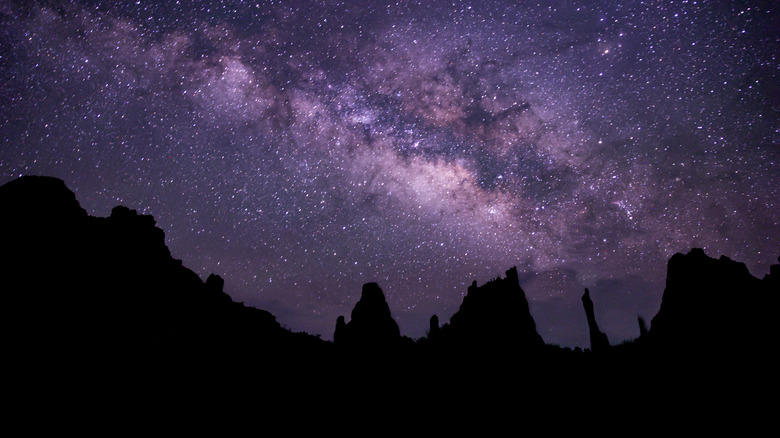
Brooks Burris/Getty Images
Texas’s Big Bend National Park includes a vast and diverse array of ecosystems, from the Chisos Mountains to the Chihuahuan Desert. A winter visit will tend to offer clear days and a break from the extreme heat of the summer. You’ll also have access to the park’s acres of wilderness, which challenge every image of Texas that you might have if you aren’t familiar with the state.
During a visit to this park, you can enjoy treks through mountain trails, vast stretches of desert, and rivers rimmed with lush grasses, flowers, and desert flora. You can also take boat rides down the Rio Grande as it rushes down towards the Gulf of Mexico, or soak in the park’s ancient, mineral-rich hot springs, which are said to have healing properties. Horseback riding is also a perfect way to experience the landscape, and if you travel far enough down south, you might even be able to take a rowboat across the river into the town of Boquillas, Mexico.
Desert nights in the winter can be chilly, so be sure to pack layers — and also, don’t forget to look up. Big Bend is listed as a designated gold-tier Dark Sky Park by the International Dark Sky Association. This means the park offers some of the darkest skies and the best stargazing in the world.
Great Smoky Mountains National Park in North Carolina and Tennessee
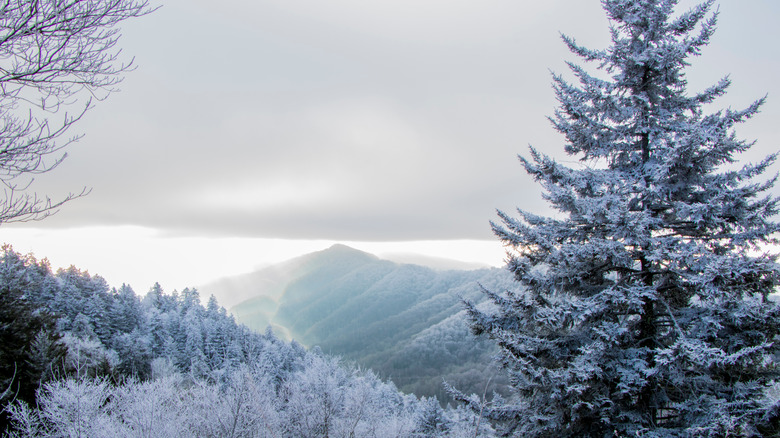
Jesse Hanson Photography/Shutterstock
A visit to the Great Smoky Mountains National Park offers the opportunity to explore one of America’s oldest mountain ranges. The Great Smoky Mountains formed around 300 million years ago, though they contain rocks that may have formed over a billion years ago, and the mountains’ age endows them with a sense of grandeur and mystery that can be felt echoing throughout the whole park.
Winter in the Great Smoky Mountains offers endless opportunities for hikers, and some routes include parts of the legendary Appalachian Trail. Winter temperatures generally rest around 50 degrees at lower altitudes and 30 degrees at higher ones, so visitors are free to enjoy scenic drives as well as the park’s dense forests, waterfalls, and wildlife, with the added benefit of far more solitude and quiet than one might find in the summer months.
Other fun activities in this national park might include everything from skiing to train rides, and camping is a great option for those looking to get a little more intimate with the landscape. The park is also full of hidden wonders — for example, if you choose to visit Elkmont, the park’s largest campground, you may also want to check out the nearby ghost town, a ruined former resort community that now is being reclaimed by the trees.
Denali National Park in Alaska
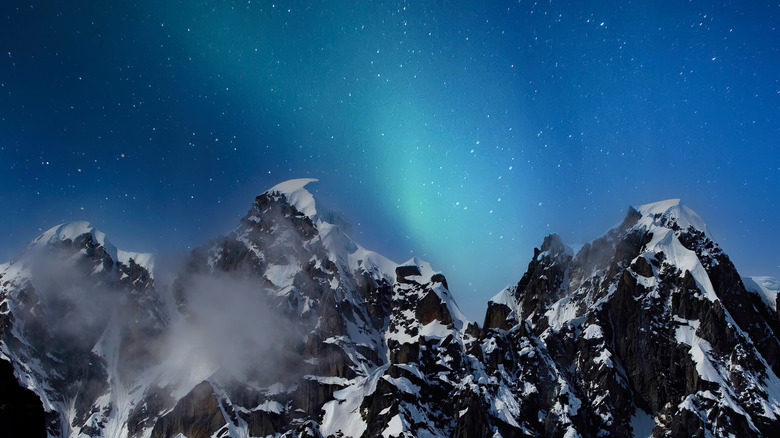
Dave Oxford/Getty Images
If you’re looking to truly embrace the winter in all of its wildly beautiful extremes, there’s no better place to visit than Denali National Park. Located about a 4.5-hour drive north of Anchorage, Alaska, this park contains a number of majestic attractions, including Denali, also known as Mt. McKinley, which is the tallest mountain in North America at 20,310 feet.
Winter visitors will have vast stretches of space to ski, snowboard, and bike through select areas of the park. It’s also possible to journey through some areas on foot, and you might even encounter a park ranger traversing the backcountry with a pack of sled dogs in tow along the way. Just be sure to remember to bundle up, because temperatures can drop far below freezing in the depths of winter.
A visit to Denali means you can enjoy anything from exhilarating rides with sled dogs to peaceful train rides that can carry you from Anchorage to the wilderness and back. You may also have the chance to drink in the sight of rapidly disappearing blue glaciers while speeding through the skies in a helicopter or plane, and if you’re lucky, you might even get to see the aurora borealis casting a glow over the night sky.
Sequoia National Park in California
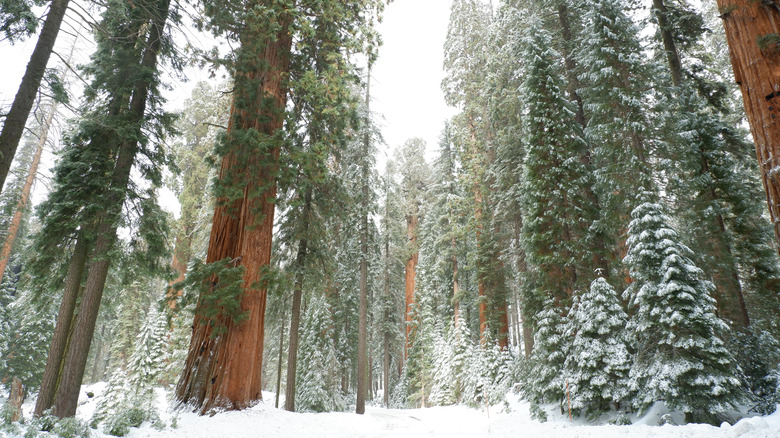
Danuponphotographer/Shutterstock
Sequoia National Park is home to the world’s largest tree, General Sherman, as well as countless other gigantic and breathtaking sequoias. Winter in Sequoia National Park offers an unparalleled opportunity to take in the park’s extraordinary trees while enjoying the serenity and silence of the woods.
In the winter, temperatures can hover around freezing, but the park’s trees are sights to behold when they’re dusted with sleek and glittering flecks of snow. From walking the Big Trees Loop to hiking the Kings Canyon Trail, the park offers limitless opportunities for truly connecting with the majesty of the natural world, and in the winter, you’ll have the chance to take in this majestic wonderland in a whole new way. Just be sure to grab your tire chains when driving through the park.
Cross-country skiing or snowshoeing are also both fabulous ways to enjoy Sequoia National Park, and sledding is also an option at one of its two designated snowplay areas. Some free ranger programs also run all year and are the perfect ways to learn more about the ecosystem you’re visiting. Unfortunately, some roads and areas of the park have been closed due to wildfires, and others are closed during winter, so like planning your winter adventure at all of these parks, be sure to map out your journey ahead of time.

